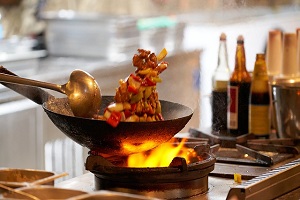Cooking is a delightful and rewarding experience, but it’s not without its hazards. Whether you’re a seasoned chef or a home cook, accidents can happen in the kitchen, and one of the most common mishaps is getting burned. A momentary distraction or a miscalculation of cooking times can result in a painful burn.
However, knowing how to handle a burn promptly and effectively can make all the difference in your cooking journey. In this blog, we’ll guide you through the steps to take if you ever find yourself with a cooking-related burn.
Step 1: Assess the Severity of the Burn
Before taking any action, it’s crucial to evaluate the seriousness of the burn. Burns are generally classified into three degrees:
- First-degree burns: These are minor burns that affect only the outer layer of the skin, causing redness and mild pain.
- Second-degree burns: More severe, these burns penetrate deeper into the skin, leading to blistering and increased pain.
- Third-degree burns: The most severe type, these burns extend through all layers of the skin and may even damage underlying tissues. They often appear white or charred and can be painless due to nerve damage.
Step 2: Remove the Heat Source
As soon as you realize you’ve been burned, the first step is to distance yourself from the heat source. Turn off the stove or oven, and if possible, move away from any hot pans or cooking equipment to prevent further injury.
Step 3: Cool the Burn
For first-degree and second-degree burns, immediate cooling is vital. Hold the affected area under cool (not cold) running water for 10-20 minutes. The cool water helps reduce pain, inflammation, and additional tissue damage. While it might be tempting to use ice, avoid it as extreme cold can harm the skin further. Cooling the burn quickly can make a significant difference in the healing process. For third-degree burns or burns covering a large area, do not attempt to cool the burn with water. Instead, cover the burn with a clean, cool, and damp cloth while waiting for medical help.
Step 4: Cover the Burn
After cooling the burn, protect it from potential contaminants by covering it with a sterile, non-stick dressing or a clean cloth. Avoid using adhesive bandages directly on the burn, as they may cause more pain and discomfort when removed.
Step 5: Find Pain Relief
Burns can be painful, and over-the-counter pain medications like ibuprofen or acetaminophen can help ease the discomfort and reduce inflammation. Always follow the recommended dosage instructions on the package and consult a healthcare professional if you have any concerns.
Step 6: Seek Medical Attention If Needed
While most minor burns can be treated at home, there are situations where medical attention is necessary. Seek immediate help if you have:
- Third-degree burns
- Burns on the face, hands, feet, or genitals
- Burns caused by chemicals or electricity
- Burns that cover a large area
Remember, it’s better to be safe and have a professional assess the burn, especially if you’re unsure about its severity.
Step 7: Prevent Infection
Keep the burn clean and dry to prevent infection. If the burn develops blisters, resist the urge to pop them, as they serve as a natural protective barrier against infection.
Cooking can be a joyful and therapeutic experience, but getting burned can happen to anyone. By knowing how to handle a burn effectively, you can minimize pain, promote faster healing, and prevent complications. Remember to assess the burn’s severity, cool it immediately, cover it properly, and seek medical attention when necessary.
With these simple steps, you’ll be better prepared to deal with any cooking mishaps and continue your culinary adventures with confidence. Stay safe and happy cooking!

